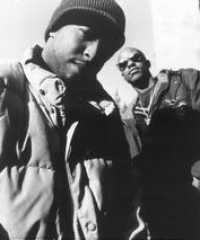Gang Starr
Production maestro DJ Premier and wordsmith Guru have defied convention since Gang Starr's first album, No More Mr. Nice Guy, establishing the gold standard for high-quality hip-hop and career longevity. First, there's Premier, probably the most consistent and highly revered producer in hip-hop, making beats for Notorious B.I.G. and Jay-Z and virtually everyone in between. His production resume includes hundreds of songs -- some hits, some not. Guru made a big splash with his solo debut, the pioneering 1993 jazz-rap album Jazzmatazz, Vol. 1. The album is notable for introducing America to MC Solaar, the tongue-twisting African-French MC, though a newcomer can skip Guru's solo albums and go straight to the Gang Starr catalogue. Though the group's first release -- which contained one of the first DJ cuts on a full-length hip-hop album -- was not at all a shabby record, No More Mr. Nice Guy pales in comparison to their later releases, but that's only because those records that followed shone so brightly.
Released in 1991, Step in the Arena sounded far ahead of its time, both slick and raw, with an unassuming touch of jazz that avoided the cliches of groups such as Digable Planets. Guru stood out as an important MC because of his easy flow and wordy rappinghood, though his only weakness is that 15 years of rhyming experience didn't change or complicate his somewhat simple, monotone delivery. In the sonic context of later albums such as The Ownerz, which highlights how far Premier has come as a producer, Guru's rhyme style sounds somewhat antiquated, though that's part of its unpretentious charm. Provided with a bed of beats delivered by DJ Premier, Guru could rhyme from Popular Mechanics magazine and still sound hot.
Daily Operation delivered darker, denser atmospherics while still never losing touch with the funk; in the era of gangsta rap, this New York crew rewrote the hip-hop playbook. Premier proved that less is more on the stripped-down opening track, "The Place Where We Dwell," while the rest of the album continued in the inventive vein of its predecessor, though with more claustrophobic production. On Hard to Earn, it seemed they could do little wrong, though after this album Gang Starr began a slow slide from relevance, but not a dramatic or devastating one.
For any other group, Moment of Truth and The Ownerz would be career highs, but for Gang Starr they just didn't live up to their jaw-dropping 1991-94 run of albums. The group's best-of collection, Full Clip: A Decade of Gang Starr, is a great introduction, but they really deserve a much closer inspection than this collection of singles and near-misses serves up. (KEMBREW MCLEOD)
From 2004's The New Rolling Stone Album Guide
Source: http://www.rollingstone.com/artists/gangstarr/biography
